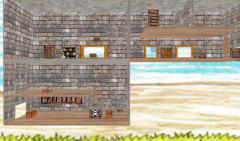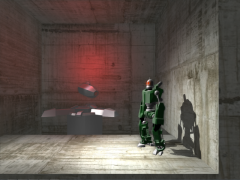Projects
Princess S. Cape
Sven Horn, Paul Varney
 Princess S. Cape is a Jump’n’Run Puzzle game. After various heroes have failed saving the princess she gets bored and tries to escape on her own. To do that she has to find her way through a labyrinth of rooms, find keys and avoid traps.
Princess S. Cape is a Jump’n’Run Puzzle game. After various heroes have failed saving the princess she gets bored and tries to escape on her own. To do that she has to find her way through a labyrinth of rooms, find keys and avoid traps.
It is basically a Jump’n’Run game where you can (and have to) move around the rooms of the level to proceed from one room to another (see Figure 1). There are various assets in the game the player interacts with. Keys can be picked up to activate doors; there are moving platforms, traps, ladders and jumpboxes. After having completed a full level and finding the exit the whole level set flips around and another world starts on the backside. To make the world a little more vivid there are small animations like animated torches on the walls or clouds and balloons flying by the windows. The graphical style of the game consists of cartoon-like textures and hand-drawn assets. The target was to make it look like a stage design from a theatre play or like a dollhouse. The background assets are 2 dimensional and sometimes that can be seen when running around in the levels. This gives the feeling that the boxes and book shelves are not real but only there to make it more beautiful (like in a stage play as mentioned before).
rotor
Alexander Kugler, Christopher Kugler, Christof Mroz, Yannis Samiro Discher
 The objective was to develop a side-scrolling jump’n’run with puzzle elements, where heavy emphasis is placed on a modern presentation employing state of the art 3D graphics effects and filters.
The objective was to develop a side-scrolling jump’n’run with puzzle elements, where heavy emphasis is placed on a modern presentation employing state of the art 3D graphics effects and filters.
Each level is divided into distinct, quadratic rooms arranged on a grid. Any time during gameplay, the room containing the main character can be rotated (subject to some rules, of course) in order to rearrange its grid position and orientation, so that what was previously a ceiling or wall can suddenly become a floor with respect to adjacent rooms, and vice versa. We decided to use a deferred rendering pipeline due to stylistic decisions. For example, the game takes place in an abandoned space ship, i.e. a sci-fi setting, and consequently draws a lot of its atmosphere from lighting. Deferred lighting makes handling of many light sources comparatively easy. Conversely, well-known disadvantages of deferred rendering, like transparent objects, proved to be unproblematic due to the predictable 2.5D camera angle.

